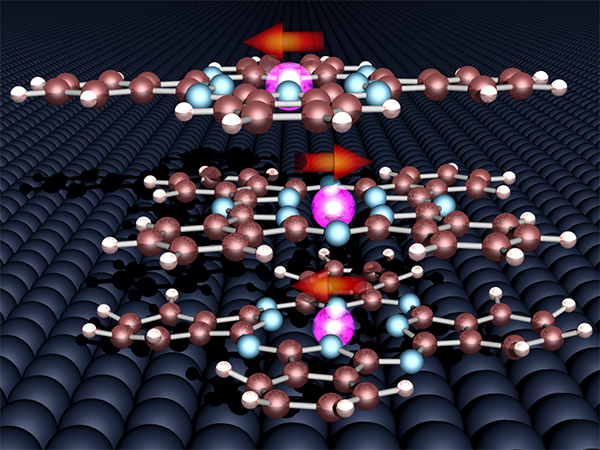When several layers of phthalocyanine molecules are deposited on a metallic surface of cobalt, the robust magnetism of cobalt can stabilize and control that of the molecules at room temperature. This established magnetic molecular ordering, which heralds a new technique to transport electron spins, can in turn control the metal’s ferromagnetism at low temperature. This effect, called exchange bias and widely used in spintronic devices, paves the way for an all-organic approach to spintronics.
Spin electronics aims to encode and process information thanks to the orientation of the elemental magnet, or spin, of the electron. Organic electronics aims to develop cheap, flexible components. Organic spintronics thus benefits from the synergies resulting from the mariage of these two research fields. Thus, researchers from the l’Institut de Physique et Chimie des Matériaux de Strasbourg (IPCMS1) showed in 2013 that the magnetism at the interface between a ferromagnetic metal such as cobalt and phthalocyanine molecules can solve the sizeable challenge in spintronics of strongly polarizing a current of electrons at room temperature.
But how does this molecular magnetism evolve beyond the interface? These researchers, with help from colleagues at the Karlsruhe Institute of Technology2, have added a new stone to this foundation by studying the magnetic interaction between two layers of cobalt and phthalocyanine. They unexpectedly discovered that this magnetic interface stabilizes the magnetism of additional molecular layers at room temperature. This molecular antiferromagnetism, which appears in a molecular crystal only at low temperature, can in turn constrain the magnetization of the cobalt layer upon cooling down the sample through a mechanism called ‘exchange bias’. These results, published in July 2015 in Nature Materials3, should enable a better control over the magnetism of organic heterostructures and spin-polarized transport through organic layers.
The researchers first deposited one molecular layer of phthalocyanine on the surface of a cobalt crystal. They then exposed this interface to X-rays from the DEIMOS beamline at SOLEIL Synchrotron4 in order to measure its absorption. When the energy of the incident beam is adjusted so as to probe the molecule’s atoms, the electronic emission reveals a magnetization of this interfacial molecular layer that is aligned to that of the underlying cobalt. Our researchers then noticed that subsequent molecular layers are magnetically coupled to the cobalt at room temperature. The direction of magnetization alternates from one molecular layer to the next. The magnetic anti-alignment of successive molecular layers underscores the stabilization of an antiferromagnetic order that is achieved at room temperature thanks to the cobalt’s robust ferromagnetism, as was confirmed by ab-initio calculations. Since the magnetization of cobalt not only stabilizes but can also reverse this antiferromagnetism, this discovery heralds a new technique to transport spin-polarized electrons across organic layers.
An antiferromagnetic layer can, when in contact with a ferromagnetic layer, block the magnetization reversal of the latter. This mechanism is called ‘exchange bias’. Our researchers have observed that the cobalt/phthalocyanine bilayer also exhibits this phenomenon below a temperature of 100 K. The effect is counterintuitive: who would have thought that the antiferromagnetic order established by the cobalt at room temperature would control it at low temperature? That the low density of electronic states within the molecular layer could affect the sea of electronic states of the metal cobalt? Thanks to this magnetic arm wrestling between metal and molecule, it should be possible to deploy this exchange bias effect within all-organic devices so as to better control their magnetic response, much as is routinely done in conventional spintronics.
1. Unité CNRS/Université de Strasbourg, France
2. Physikalisches Institut and Institute of Nanotechnology, Karlsruhe Institute of Technology, Allemagne
3. Gruber, M. et al. Exchange bias and room-temperature magnetic order in molecular layers, Nature Materials, online on July 20th, 2015
4. Synchrotron SOLEIL, France

Three phthalocyanine molecules on a cobalt crystal. At room temperature, cobalt stabilizes the magnetism of the molecular layers that is schematized by arrows. This magnetic molecular order can in turn control the magnetism of cobalt at low temperature.
